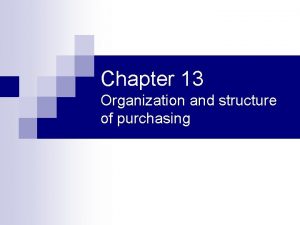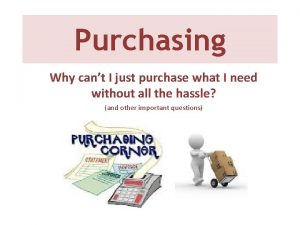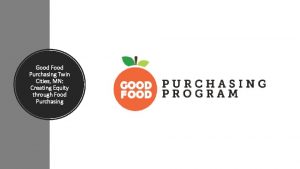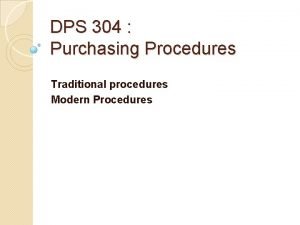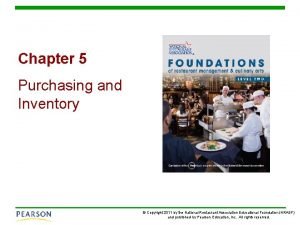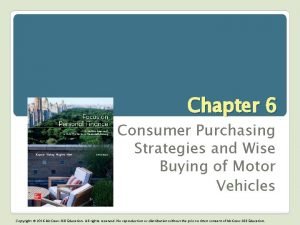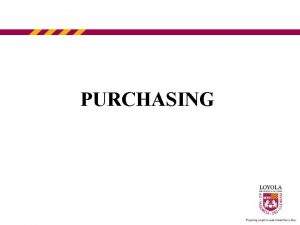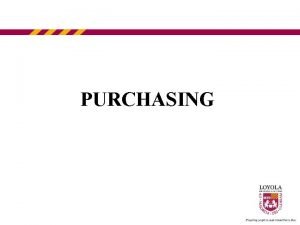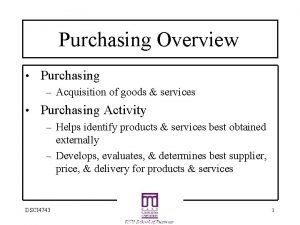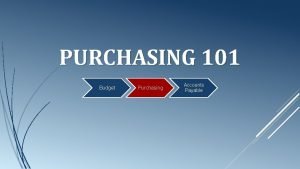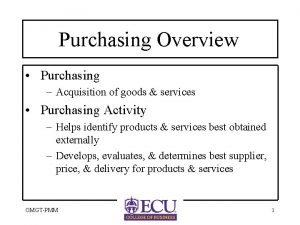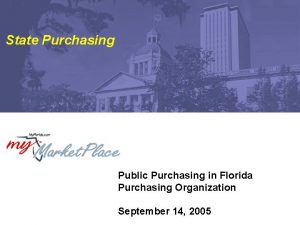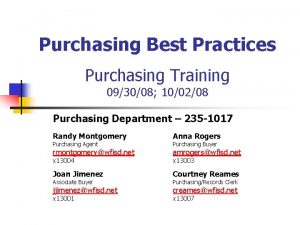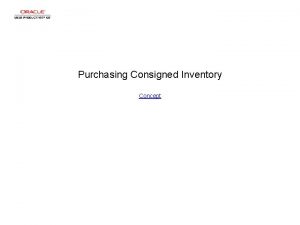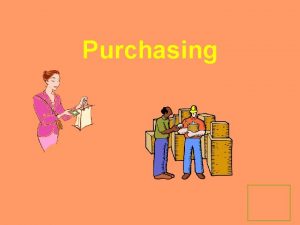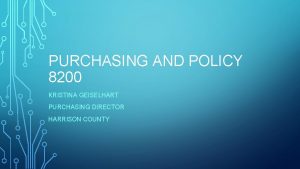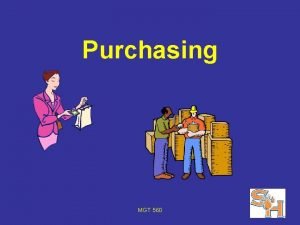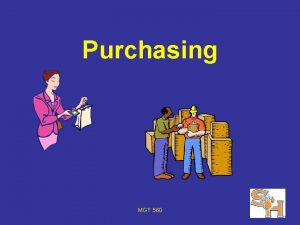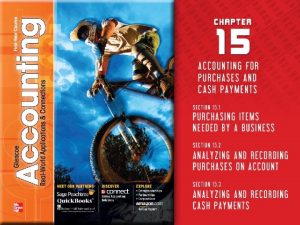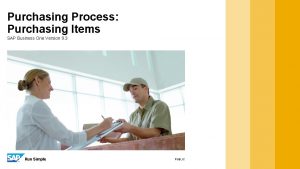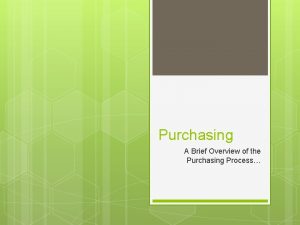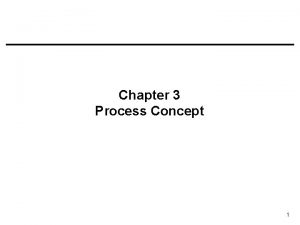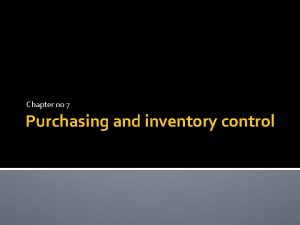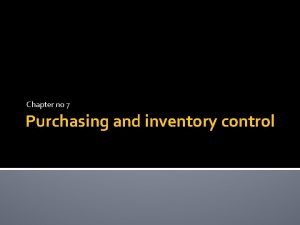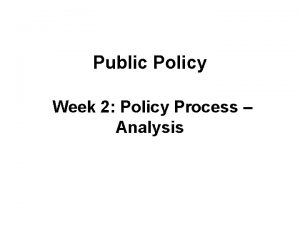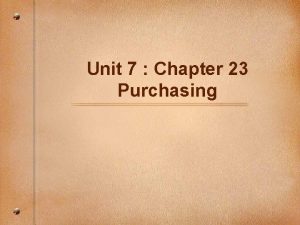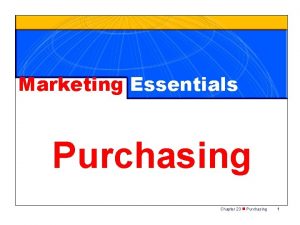CHAPTER OUTLINE The Purchasing Process Purchasing Policy and





























- Slides: 29


CHAPTER OUTLINE • The Purchasing Process • Purchasing Policy and Procedures • Purchasing and Supplier Integration for Competitive Advantage • Purchasing and Supply Chain Organization • Purchasing and Supply Chain Analysis : Tools and Techniques

LEARNING OBJECTIVES • Understand the key objectives and responsibilities of purchasing function • Explain the concept of purchasing process, policies and procedures • Identify the supply chain concept and various forms of purchasing strategy aimed at gaining competitive advantage

PURCHASING What is Purchasing? A form of buying that consists in getting the goods or services by paying a certain amount of price or money. The amount of money or price paid in the case of purchasing will be in accordance with the quality and quantity of the goods or services. A process made up of all activities associated with identifying needs, locating and selecting suppliers, negotiating terms and following up to obtain goods and services.

PURCHASING OBJECTIVES Supply Continuity Manage the Purchasing Process Efficiently and Effectively Develop Supply Base Management Develop Aligned Goals with Internal Functional Stakeholders Support Organizational Goals and Objectives Develop Integrated Purchasing Strategies that Support Organizational Strategies

PURCHASING RESPONSIBILITIES Evaluate and Select Suppliers Review Specifications Act as the Primary Contact with Suppliers Determine the Method of Awarding Purchase Contracts

PURCHASING PROCESS

PURCHASING PROCESS a) Forecast and Plan Requirement § Begin purchasing cycle – need (requirement) identification § Review spending pattern and prepare a forecast of what will be purchased § Purchasing is the primary vehicle for obtaining external inputs (services and product) from suppliers § Purchasing personnel have to work with a large number of internal customers – understand plan for what they will be buying Spot buy – situations that arise when an internal customer has a need that comes up suddenly which is not planned for

PURCHASING PROCESS b) Need Clarification: Requisitioning Common method: Purchase requisitions / statement of work • Description of required material or service – – • • • By market grade or industry standard By brand By specification By performance characteristics Quantity and date required Estimated unit cost Operating account to be charged Date of requisition (this starts the tracking cycle) Authorized signature

PURCHASING PROCESS c) Supplier Identification and Selection § Once the needs are identified, one of these can happen: • the need fulfilled by a an existing supplier • the need fulfilled by a new supplier § Two common ways: • competitive bidding • negotiation § Send Request for Quotation (RFQ) to supplier § Include additional information or attachments to assist if the requested item is complex or untested or new production § Evaluate suppliers

PURCHASING PROCESS d) Approval, Contract and Purchase Order Preparation § After supplier is selected, approval to purchase the product or service is granted § Several different approaches, depending on the system: ü Purchase Order (PO) / Purchase Agreement ü Blanket Purchase Order ü Material Purchase Release ü Fixed-Price Contracts • Firm Fixed Price • Cost-Based Contracts

PURCHASING PROCESS e) Receipt and Inspection § Involves physical transmittal of purchase requirements and it should be a fairly routine § Purchasing or materials planning must minimize the time required to release and receive material and need to closely monitor the status of open purchase orders § Several important documents that involved: ü Material packing slip ü Bill of lading ü Receiving discrepancy report JIT Purchasing – allows firms to eliminate most receiving forms

PURCHASING PROCESS f) Invoice Settlement and Payment § Once the item or service is delivered, authorization for payment will be issued § Payment is made through company’s account payable department § Integrated systems: Electronic Funds Transfer (EFT) § A record of critical events associated with the purchase is entered into a supplier performance database – identify trends or patterns § Continuously measure and manage supplier performance

PURCHASING POLICY § Policy : set of purpose, principles and rules of action that guide an organization § Characteristics apply to effective policies: ü Action oriented and relevant (avoiding trivial or unimportant issues) ü Concise (stating a position with a min. number of words) ü Unambiguous (well understood) ü Timely and current ü Guide problem solving and behavior - Advantages: define and clarify top management objectives; provide a framework for consistent decision making and action Disadvantages: Often difficult to communicate throughout large organizations; employees might view policies as a substitute for effective management; can restrict innovation and flexibility

PURCHASING POLICY Categories of Policy a. Policy defining the role of purchasing b. Policies defining the conduct of purchasing personnel c. Policies defining social and minority business objectives d. Policies defining buyer-seller relationships e. Policies defining operational issues

PURCHASING PROCEDURES § Procedures: operating instruction detailing functional duties or task (a how-to manual) § Purpose of a procedure: ü A reference guide for purchasing personnel – explaining about how to accomplish different activities or assignments ü Provides consistency and order by documenting the step and activities required to perform a task § Primary emphasis: development of a concise, accurate and complete set of operating instructions § Existing procedures may no longer apply when wellestablished processes are changed

PURCHASING PROCEDURES Most of purchasing procedures correspond to one of the following areas: a. The Purchasing Cycle üproper steps to follow during each stage of the cycle b. The Proper Use of Purchasing Forms ütypical purchasing function relies on many form to conduct its business c. The Development of Legal Contracts üspecific procedures for contracting with outside suppliers and individuals d. Operational Procedures üprovide instruction and detail across a broad range of topics ücovers from following a specific set of steps ürequires consistent action to promote efficiency üto carries out directives of functional or executive policies

P&S INTEGRATION - The process of incorporating or bringing together different groups, functions, or organizations - Either formally or informally, physically or by information technology - To work jointly and often concurrently on a common business-related assignment or purpose - Can occur in many forms: - through functions such as in new product development - through cross-location - Supply management’s linkages divided to: - internal - external

INTERNAL INTEGRATION Must maintain a number of communication flows and linkages To facilitate integration with other internal function Become stronger and more important as the role of supply management continues to develop and evolve

EXTERNAL INTEGRATION § Supply management represents the external face of the organization § Serve as the primary vehicle to integrate external suppliers and other entities into the organization § Acts as a liaison with external parties on multiple fronts (materials, new technology, information and services) § Linkages: Suppliers Government Local Communities

EXTERNAL INTEGRATION Collaborative Buyer-Seller Relationship Collaboration - Process by which two or parties adopt a high level of purposeful co-operation to maintain a trading relationship over time • Characteristics defining the relationship: 1. One / limited number of supplier for each purchased item 2. A win-win approach to reward sharing 3. Joint efforts to improve performance 4. Open exchange of information 5. A credible commitment to work together during difficult times 6. A commitment to quality

EXTERNAL INTEGRATION

P&SC ORGANIZATION Purpose of organization structure: • Shows the assignment of work along with the authority that accompanies those responsibilities • Formal structure – helps in defining how the firm communicate and integrates decision making throughout the groups • Physical placement of purchasing – indicate its organizational status and influence • In some organizations the highest purchasing professional reporting status is on par with other major functions

P&SC ORGANIZATION Factors Affecting Purchasing Position: a. History b. Type of industry c. Total value of goods and services d. Type of purchased materials e. The ability to influence a company’s performance

P&SC ORGANIZATION • Various methods of organizing the function: – – Organization by end product Organization by category Organization by value classification Organization by profit centre • Centralization/Decentralization – Complete decentralization: allowing full autonomy in each of the units – Complete centralization: which in practice means that apart from local purchases of small value, all purchases are made from a central office – A combination of the two

PURCHASING DEPT. ACTIVITIES • Buying • Expediting – contacting suppliers to determine status • Inventory control – manage using sophisticated equations or algorithms to facilitate balancing of product • Transportation – evaluate, negotiate and select • Managing countertrade arrangement – international or domestic • Insourcing/Outsourcing • Value analysis • Purchasing research/material forecasting • Supply management – progressive approach to manage supply base • Other responsibilities – receiving and warehousing, managing company travel arrangements, production planning etc

P&SC ANALYSIS • Strategic analysis: understanding the relationship between different factors affecting the organization and its choice of strategies • The 3 main area for analysis are: – The environment – Internal resources, competencies and strategic capabilities – Stakeholders’ expectations

P&SC ANALYSIS Analysis Methodologies Environmental analysis PEST (political, economic, social, technological) analysis SWOT (strengths, weaknesses, opportunities, threats) Porter’s five forces, Competitor analysis Competitive position Strategic group analysis, Competitor analysis Resources analysis, competencies and strategic capabilities Value chain analysis, Resource audit, Core business Comparative analysis Historical and financial analysis, Benchmarking Organizational analysis SWOT, BCG (Boston Consulting Group) analysis, Critical success factors (CSFs) Stakeholders’ perceptions Ethical considerations, Stakeholder mapping, Mission statements, Culture, Paradigms

SUMMARY • Purchasing process have: ü 6 objectives ü 4 responsibilities ü 6 steps • Policy and procedures is essential for understanding how organizations operate and work • Organization need to develop closer relationship with internal and external groups in order to become competitive
 Purchasing organization structure
Purchasing organization structure Purchasing images
Purchasing images Good food purchasing
Good food purchasing Responsible purchasing policy
Responsible purchasing policy Sandwich sentences
Sandwich sentences Traditional purchasing process
Traditional purchasing process Chapter 5 purchasing and inventory
Chapter 5 purchasing and inventory Loan vocabulary
Loan vocabulary Chapter 6 consumer purchasing and protection
Chapter 6 consumer purchasing and protection Chapter 3 your purchasing power
Chapter 3 your purchasing power Hát kết hợp bộ gõ cơ thể
Hát kết hợp bộ gõ cơ thể Frameset trong html5
Frameset trong html5 Bổ thể
Bổ thể Tỉ lệ cơ thể trẻ em
Tỉ lệ cơ thể trẻ em Chó sói
Chó sói Thang điểm glasgow
Thang điểm glasgow Chúa yêu trần thế
Chúa yêu trần thế Môn thể thao bắt đầu bằng từ đua
Môn thể thao bắt đầu bằng từ đua Thế nào là hệ số cao nhất
Thế nào là hệ số cao nhất Các châu lục và đại dương trên thế giới
Các châu lục và đại dương trên thế giới Công của trọng lực
Công của trọng lực Trời xanh đây là của chúng ta thể thơ
Trời xanh đây là của chúng ta thể thơ Cách giải mật thư tọa độ
Cách giải mật thư tọa độ 101012 bằng
101012 bằng độ dài liên kết
độ dài liên kết Các châu lục và đại dương trên thế giới
Các châu lục và đại dương trên thế giới Thể thơ truyền thống
Thể thơ truyền thống Quá trình desamine hóa có thể tạo ra
Quá trình desamine hóa có thể tạo ra Một số thể thơ truyền thống
Một số thể thơ truyền thống Cái miệng nó xinh thế
Cái miệng nó xinh thế
